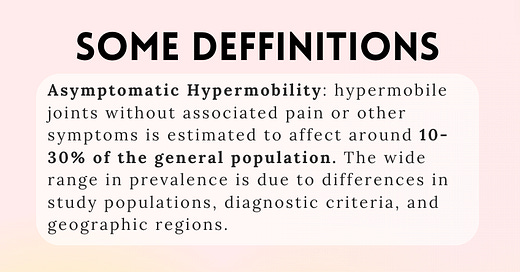Yes, Bendy CAN Be Benign
Being Hypermobile Does Not Always Mean You Have A Connective Tissue Disorder
Recently, there’s been a growing trend on social media where all forms of joint hypermobility are being labeled as Ehlers-Danlos Syndrome (EDS) or another connective tissue disorder (CTD). This trend is not only inaccurate but also potentially harmful. (Yes Taylor swift has hypermobile elbows - this doesn’t mean she’s part of the EDS club, as much as we would love to welcome her!) I partnered up with Taylor Goldberg (@TheHypermobileChiro) to cover this topic.
Understanding Hypermobility
Hypermobility simply refers to joints that can move beyond the typical range of motion. It’s important to note that many people have joint hypermobility without ever experiencing any health problems. This is known as asymptomatic hypermobility and is quite common, affecting up to 30% of the general population, depending on factors such as geographic location, diagnostic criteria, and study populations. Asymptomatic hypermobility can often limited to one or a few joints, and not even generalized throughout the body.
We are noticing a concerning trend of generalizing hypermobility as a systemic issue for everyone. While joint hypermobility is a key feature of some medical conditions, such as the Ehlers-Danlos syndromes (EDS), it's important to recognize that asymptomatic hypermobility also exists in the general population. Pathologizing hypermobility across the board is not only inaccurate, but also potentially harmful.
The Harm of Overgeneralization
By generalizing all hypermobility as a systemic issue or a sign of a CTD, we risk causing unnecessary fear and confusion. People with no symptoms may start worrying about conditions they don’t have (I have personally received many messages from people with no symptoms but a few hypermobilty joints, concerned they will now have an aortic aneurysm - and health anxiety can be very debilitating for some). Additionally, those in real need of medical attention might be overshadowed by the noise, especially with the long waitlists and limited access to specialists for EDS patients already.
By distinguishing between asymptomatic hypermobility and medically significant cases, we can prevent unnecessary alarm, focus healthcare resources where they are needed, and help individuals with symptomatic hypermobility receive the care they require.
How We Can Do Better
In a clinical setting, this discussion might seem unnecessary because if a patient is in the office, they are likely symptomatic; otherwise, they wouldn't be seeking medical attention. However, if your audience isn’t limited to those in a clinical setting—your posts reach a much broader, more diverse group online.
It’s important to remember that while hypermobility can be a characteristic of certain connective tissue disorders, the presence of hypermobility alone is not enough for a diagnosis of a CTD. For those with symptomatic hypermobility, proper evaluation and care are crucial. This can include a clinical evaluation, often paired with with genetic testing.
For those online - being mindful of the language used on public platforms is essential to prevent misunderstanding and alarm. By carefully framing discussions about hypermobility, we can provide valuable information while ensuring that we don't unintentionally create excessive concern.






Regarding Taylor Swift, she may have asymptomatic hypermobility however she also has some of hEDS/HSD comorbidities… ASD( gifted, some OCDs,( watch her movie),eating disorder at one time.
There’s been asymptomatic athletes that end up having something trigger the EDS gene then they become symptomatic. Hypermobility should be a red flag even if asymptomatic. One should investigate for the possibility of it being from a HCTD so they could be mindful of it and be proactive.
Hi Cortney, I admire your work and appreciate your advocacy, but I think it is harmful to patients to use hypermobile and benign in the same sentence.
While it is true that not all hypermobile people are ill, we know that many are, in fact, very ill and have had their symptoms dismissed--for years, and even decades--by misinformed medical professionals who failed to connect these patients' myriad health problems with their hypermobility.
The truth is, there is so much that we simply don't know about these people/patients, because it is so grievously underdiagnosed. I read recently an estimate that 80% of hEDS patients are undiagnosed, and I have seen figures even higher. We may very well learn eventually that most/all patients with complex chronic illnesses including ME/CFS, fibromyalgia, and long COVID (just to name a few) meet diagnostic criteria for connective tissue disorders; we can already see strong signals for those associations.
I suspect we will ultimately find a bimodal distribution in overall "healthiness" of people with heritable connective tissue disorders: some being models of fitness and remaining remarkably healthy even into old age, and others clustering around the other end of the spectrum, having multiple chronic illnesses and degraded quality of life beginning in younger years. Such a distribution would still not necessarily imply hypermobility being benign. There are multiple paths to such a distribution, including that those at the "extra healthy" end of the spectrum have certain protective factors that compensate for the errors in their connective tissues.
Concerns about health anxiety are overblown in my experience, and they are often punitively wielded against patients, especially women and minorities; they have resulted in paternalistic norms in medicine that deny patients knowledge about their own bodies. Knowledge is power, and knowledge that one has risk factors for serious health complications enables patients to take preventive measures and also to be better advocates for themselves when problems do arise. So many of us have been denied that knowledge and the agency to prevent harm to our bodies, and we've been traumatized by the inability of our clinicians to recognize our hypermobility as pathologic.
I believe your message has value, but I hope you'll consider reframing the article, perhaps toward questions of whether all hypermobile people are doomed to be sick (NO!) and directing people toward preventive interventions.